|
|||||
FlyingRC.net is a
Veteran-Owned site.

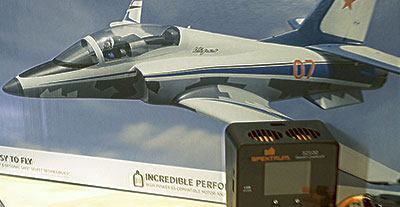 |
| I know, I swore off foamie jets, until I saw the E-Flite Viper 70mm EDF in person. Click image to enlarge |
E-Flite Viper 70mm EDF Jet BNF Basic
I lied, there is a jet in my life, and nothing froze over
Text, photos and video by Tom Hintz
Posted–9-4-2019
At a recent electric fun fly, Ronnie, a friend of mine (and an exceptional pilot) was flying an E-Flite Viper 70mm EDF and my resistance to electric jets began to waiver. Then as the string of jet pilots asked how he had modified it were told it was “box stock” I pretty much threw in the proverbial towel and secretly plotted my acquisition of my first EDF jet.
A Word of Caution
The E-Flite Viper 70mm EDF (electric ducted fan) is touted as a great first jet and that appears to be true. However, too many people are interpreting that as meaning this can be your first RC plane which is very far from reality. Having intermediate flying skills should be considered the minimum. Even then, getting the help of someone experienced with jets and perhaps using a buddy box could save you a bunch of money, and your first jet. The AS3X and SAFE Select flight control systems help, but you still need to be flying this jet all the time or it’s gone or in a fresh hole someplace. Also, this is no park flyer. You need a dedicated flying site as this plane covers lots of ground quickly.
The Basics
The E-Flite Viper 70mm EDF is a replica of the famous Viper full scale plane but it sports a color scheme by Aircraft Studio Design. The main construction material is the durable EPO foam. This is a full 6-channel plane that really needs a 7-channel transmitter if you want to use the SAFE system. If you need a transmitter, buying anything under a 9 channel these days doesn’t make good sense, fiscal or otherwise.
The E-Flite Viper 70mm EDF has a wingspan of 43.3 in (1100mm) and is 40.4 in (1025mm) long. It has a projected flying weight of 4.2-4.4 lbs (67-70 oz) with the variance likely being battery weight between mAh capacities.
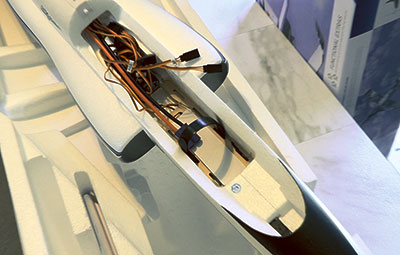 |
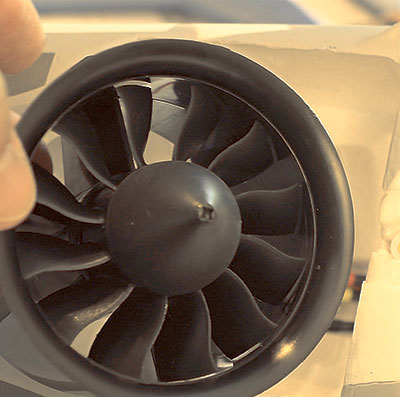 |
| The E-Flite Viper 70mm EDF has a large battery bay (left) that accepts all legit sizes for this plane. The fan (right) is impressive and explains much of this E-Flite Viper 70mm EDF performance. Click images to enlarge |
|
The E-Flite Viper 70mm EDF has E-Flite metal geared servos factory-installed with one on each elevator half, each aileron, each flap and one on the rudder. Also, factory installed are electric retracts including a retractable, steerable nose wheel. These retracts have coiled wire struts that I like way better for this application than the more scale-looking oleo-style struts when it comes to surviving grass or otherwise un-flat fields.
Power Equipment
The Viper has a 70mm EDF, 12-blade fan powered by a brushless 2860-KV1850 motor running on 6S 22.2V 3200-4000mAh LiPo packs with the EC5 connector. Throttle control is provided by a 70A speed control with BEC to power the radio gear. Projected flight times are around 4 minutes, but I suspect as with many electric planes, the actual time you get depends heavily on your flying style. The range of battery capacities also has something to do with flight times but how hard you run the motor remains king of the power consumers.
Flight Control Systems
This E-Flite Viper 70mm EDF is the BNF (bind and fly) version. A Spektrum™ 6- channel DSMX® receiver with AS3X® stabilization comes already installed and programmed. Flight stabilization has become virtually standard equipment on jets from EDF to full-on turbines.
This jet also has the SAFE® Select flight system. The “Select” part of the name means it can be turned off or the plane bound without it in force. Experienced pilots probably won’t like SAFE as it dramatically limits control throws. Though I have yet to fly the E-Flite Viper 70mm EDF, I will forgo the SAFE® Select flight system.
Assembly
One aspect of today’s ARF’s (almost ready to fly) is easier, faster assembly. The E-Flite Viper 70mm EDF needs only a 1.5mm hex wrench to assemble or break down if needed for transport. All the screws are the same size, a bit of design sanity that has eluded manufacturers for way too long.
The E-Flite Viper 70mm EDF wing is one piece with composite reinforcement and comes with the aileron and flap servos installed and linkages in place. The linkages have a Z-bend on the servo end and a ball link on the control surface horn. Again, nice design that helps insure and consistent, smooth-responding plane with minimal play at the control surfaces.
Wing Installation
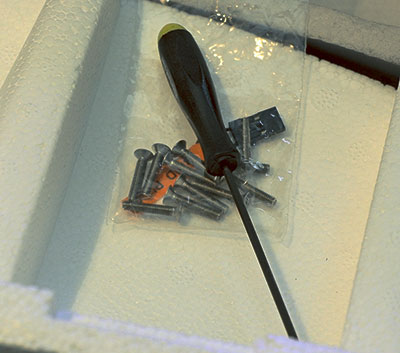 |
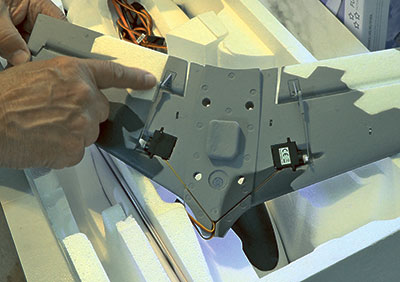 |
| Overcome by reality the design team made the E-Flite Viper 70mm EDF so it uses one size screw (left) and one size driver. The servos and good linkages (right) are installed at the factory. Mine were adjusted very close to perfect. Click images to enlarge |
|
Assembling the wing to the fuselage means we have four cables that need to get to the receiver. All the cables are labeled as are the extensions coming from the receiver. E-Flite even put an extension in the receivers bind socket that is not visible as it is installed.
There was a little adult language uttered when I first tried installing the wing, something I thought might be considered field assembly to simplify transport. The aileron and flap servos are on Y-harnesses so the number of wires that go to the receiver are reduced which helps make this operation possible. Not fun, but possible.
The hole through which the wires emerge from the fuselage match up with a similar hole where they exit the wing. If you look into this hole from the underside you will see the issue. Many of the receiver wires are in the path the wing wires need to pass through to connect to the receiver extensions.
I found that wrapping the first couple inches of the cable bundle with masking tape helped keep them together as I fished them through from the top of the fuselage. If this sounds like a frustrating bit of balancing the wing with one hand, pushing the cables into the passage with the other hand and fishing them through from the top with your third hand, you are correct. I got it done and the wing screwed in place where it will stay until there is smoke or something forcing me to remove it. The good news here is the size of the E-Flite Viper 70mm EDF, allows it to fit most vehicles fully assembled.
The Hatch
The canopy area comes off providing good access to the battery compartment. While the E-Flite Viper 70mm EDF is rated for up to 4000mAh battery packs it is important to remember that not all batteries are the same dimensions, even those with identical mAh ratings. I went with 3200mAh Spektrum Smart Packs and they fit well with no modifications to the fuselage cavity or bottom of the canopy.
The removable top hatch is secured with a sliding pin. At the speeds the E-Flite Viper 70mm EDF flies and its aerobatic capabilities a magnet-retained canopy would likely be a gonner. The canopy does have a scale-looking pilot for that little bit of reality while it sits in the pits. In flight, things like the pilot figure are reduced to a blur.
Retracts
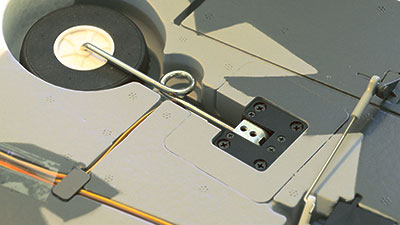 |
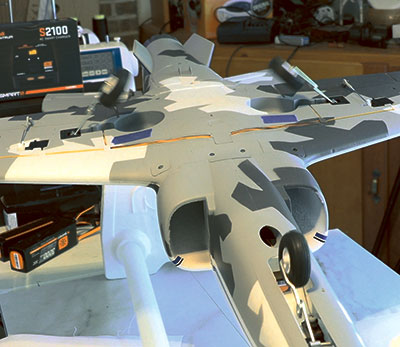 |
| The factory installed retracts (left) have coiled legs that are way more sensible off of most runways. Some are complaining that he retracts are too fast (right) but I think that is a lot of hooey. I want the wheels up and out of the air stream quickly anyway. Click images to enlarge |
|
The factory installed electric retracts worked fine and all look to be nicely aligned. I expect the wheels are a little oversize in terms of scale, but they should be a good compromise for flying off grass and pavement. One club I fly with has a nice grass runway; the other club has a large Geotex fabric section with a longer grass strip net to it. I should be golden at either field.
I know some are going to scoff at the speed with which electrics operate but we are not talking a scale plane here. I am fine with the E-Flite Viper 70mm EDF sucking the wheels up relatively quickly to “clean up” the aerodynamics and let this model gain speed more quickly.
Balancing
When researching the E-Flite Viper 70mm EDF I watched a video where the narrator talked about putting his battery pack “about a thumb width” aft of the front end of the battery compartment. When I got the balance as close to perfect as I could, the space ahead of the pack is almost exactly the width of my thumb. On the Internet, that kind of legitimacy is spooky.
It's been years since I balanced a plane that I could hold on my fingertips, so I started that way, getting it as close to 85mm back of the leading edge of the wing at the root. Then I got out my Xicoy Digital Weight & Balance CG Meter Pro to see how close I had gotten. I had to move the pack back roughly another ¼” to get the computerized reading down to .1lbs nose heavy, again at the center of the suggested CG range. I will be doing a full Review of the Xicoy Digital Weight & Balance CG Meter Pro soon,
Incidentally, my E-Flite Viper 70mm EDF weighs in, with the Spektrum Smart™ 3200mAh LiPo pack at just 3.98lbs. Not sure why it is a tick underweight but after looking for missing stuff or unexplained holes and finding none I’m done asking questions.
It Needs Exercise
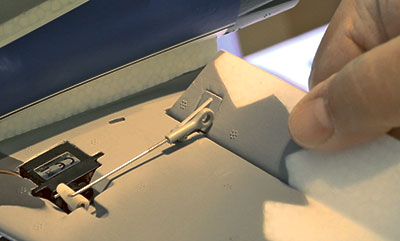 |
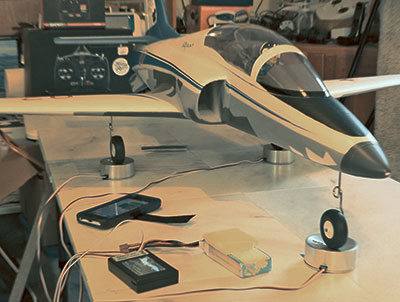 |
| I know many will blow right past the "exercise the control surfaces" part of the instructions (left) but it is a very good idea and simple to do. I used my Xicoy digital balancer (right) just to see how close balancing on my fingers was with this plane. It was right on the money. Click images to enlarge |
|
After checking everything over it was time to “exercise” the control surface hinging. The E-Flite Viper 70mm EDF uses the EPO foam itself for hinges. Don’t ask me how that material can flex over and over without falling apart. It just does.
As it comes from the factory the hinging can be a little stiff. To be sure we are not straining servos or having control surfaces resist returning to neutral we need to work the control surface hinging several times to “loosen” them up. Some folks do this with the linkage connected and if you are careful not to stress the servo gears it should be OK. I like to pop the ball links off and flex the control surface, then snap the ball link back in place. It takes a little longer and it helps to have a ball link pliers, but I think it is worth the effort.
Radio Setup File
It is important to read the manual and follow the binding procedure exactly. There is a provision for binding with the SAFE system enabled and a slightly different binding procedure to bind with no SAFE system. Either way the AS3X stabilization is enabled. Keep in mind that while the SAFE system will right the plane if you lose control, it will not fly it back to you. If you are not actively flying the plane after the SAFE system rights it, the crash site will be much farther away. If you are unsure, get the help of a qualified pilot to get you comfortable with flying this very fast E-Flite Viper 70mm EDF, and remember the throttle stick. Slowing the E-Flite Viper 70mm EDF down can help a bunch.
The instruction manual has instructions for setting up a wide range of Spektrum transmitters. However, if you registered your Spektrum transmitter on www.spektrumrc.com you can go to that transmitter in the My Spektrum section (after logging in) to find a list of model files for a ton of planes, all of which are related to Horizon Hobby. E-flite, Hangar 9 and more are well represented.
I looked in that list and they had a model file for the E-Flite Viper 70mm EDF that allowed me to Import it into my Spektrum iX12 and poof, I was set up, almost. I did have to reverse the numbers on the flaps to get them going in the correct direction but that was it. I did not change anything else. When using a setup file like this make sure you confirm EVERYTHING before putting the plane in the air!
Conclusions
Video Tour |
|
Except for fishing the wires through the fuselage assembly of the E-Flite Viper 70mm EDF was quick and simple. Having an assembled, very fast-looking jet on the bench makes one long for the flying field. Between the pure speed of the E-Flite Viper 70mm EDF and its camouflage coloring I will wait for sunny days for at least the initial flights.
I paid $249.95 (8-1-2019) for the E-Flite Viper 70mm EDF and now having seen everything in the box, that doesn’t seem too bad in today’s RC world. If the reports of being a fun flying plane are even mostly true, the E-Flite Viper 70mm EDF looks to be a decent way to spend some of my RC dollars.
The somewhat over-sized wheels should allow the E-Flite Viper 70mm EDF to fly out of grass as well as pavement or Geotex. That means it will be better for more people than many jets in this size range.
Next up is the maiden flight. Stay tuned!
Resources
Have a comment on this Review? – Email Me!
Back to the Reviews List
All Flyingrc.net written, photographic and drawn materials are property of and copyright by Tom Hintz and Flyingrc.net 2013-2020 Materials cannot be used in any way without the prior written permission of the owner.
Privacy Statement


